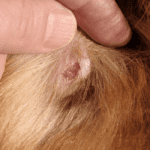- Nom Nom Dog Food Subscription Review - November 7, 2023
- 7 Best Dog Bed Ideas For Great Dane (DIY Options) - July 16, 2022
- Top 5 Rated Best Non-Prescription Diabetic Dog Food - July 15, 2022
All dog lovers understand that bringing a dog into our families is a commitment that comes with many joys and many responsibilities. Perhaps the toughest responsibility we pet parents shoulder is making healthcare decisions for our beloved canine companions, especially when these decisions are critical enough to determine the quality of life for the remainder of our dog’s time with us, or even whether he lives or dies–and when. Making these choices is not only heart-wrenching, but also both financially and emotionally costly. To assist with the financial aspect, some pet parents opt to purchase pet insurance, which can offset their pet’s health care costs, and sometimes even help mitigate the emotional impact of a difficult decision: A good friend of mine–a fellow devoted dog mom–recently told me that with pet insurance, financial expenses become secondary to the health, safety, and care of her pets. Deciding whether or not purchasing pet insurance is right for you and your dog can be challenging. In this case, we will examine one of the most common cancers in dogs, hemangiosarcoma, or tumors in the spleen. We will discuss its symptoms, possible treatments, and what you and your dog can expect to experience during treatment, as well as the typical costs. Finally, we will evaluate various coverage plans to help you decide if pet insurance might be helpful for you and your fur baby if you ever face this condition together.
What Is Hemangiosarcoma, What Are the Symptoms, and Why Is Addressing It Important?
Hemangiosarcomas, or tumors found most commonly in the spleen, form in the blood vessels and thus can easily spread to other organs, transported throughout the body along the blood cells’ routes. Because blood vessels feed these tumors and fill them with blood, they can burst, causing unexpected hemorrhage, collapse, and, often, death. The condition is more common in male than female dogs, and is particularly prevalent in larger breeds like German shepherds, boxers, and retrievers. It typically arises between the ages of 8 and 10, and the majority of dogs diagnosed with the condition do not live a full year after initial diagnosis.

Unfortunately, hemangiosarcoma is difficult to detect, and most pet parents don’t know their dog is experiencing the condition until one or more tumors rupture. Symptoms of a rupture can include collapse, labored breathing, sudden weakness, or sudden death. Other symptoms can include but are not limited to: lack of energy, lack of appetite, weight loss, and nose bleeds. In some cases, hemangiosarcoma can be detected earlier through ultrasounds, X-rays, or abdominal palpations.If you suspect your dog is suffering from the disease, there are a number of tests your veterinarian can perform to detect it. These include chest and abdominal X-rays, abdominal ultrasound, heart ultrasound, physical exam, complete blood count (CBC), CT scan of organs that might be affected, blood biochemistry panel, and urinalysis. No means to prevent internal hemangiosarcoma (tumors that affect the internal organs) currently exist.
Despite the fact that survival time is short and detecting hemangiosarcoma in time to stop its spread is rare, addressing the condition if your pet is found to be affected by it is important in order to sustain his quality of life, keep him comfortable, and perhaps extend your time together.
How is Hemangiosarcoma Treated and What Happens During Treatment?
Chemotherapy is highly recommended. This treatment not only increases the chance of preventing the cancer’s spread, but also often prolongs the patient’s life. If chemotherapy is ineffective or does not seem like a kind or practical option for your dog, administering a low dose of a variety of drugs designed to lengthen his life and extend his comfortable days can be an alternative.
When hemangiosarcoma is suspected or found in the spleen, which is the case in 50% of dogs that suffer from the disease and is the most commonly affected organ, the most frequent treatment, in addition to chemotherapy, is a complete splenectomy (surgical removal of the whole organ). In some cases, this surgery may reveal that your dog is actually suffering from a much more benign condition, called hemangioma. Providing that is the case and the cancer has not spread anywhere else in the body, the splenectomy can sometimes cure the problem, and you can expect your dog to recover. Without chemotherapy, most dogs who are found to indeed be suffering from hemangiosarcoma live only another 2 to 3 months. Combined with chemotherapy, dogs whose spleens are surgically removed could live 5 to 7 months post-operation. Ten percent of dogs live longer than a year after their surgery. During the surgery, you can expect your veterinarian to closely examine your dog’s entire abdomen for any and all lesions to be removed. When the surgery is complete, many dogs experience an irregular heartbeat, which must be monitored closely and usually resolves within a day or two. In addition, your dog will likely appear much thinner post-operation, and you will see a long incision where the spleen was removed from your dog’s abdomen. You may need to administer an iron supplement to your dog to help him recover from any blood loss, and your vet is also likely to prescribe antibiotics and painkillers.
All that said, upon their dog’s diagnosis with splenic hemangiosarcoma, many dog parents feel euthanasia is the most loving option for their dog. If they haven’t already, there is no way to predict when the tumors might rupture, and once a rupture occurs, death is almost inevitable, and is likely to cause the dog both distress and suffering. In addition, even after a traumatic splenectomy, a dog suffering from hemangiosarcoma has a survival time of less than a year–likely be only a few months. Some dog parents feel prolonging their dog’s life in the face of such likely suffering is unkind to their companion. Believing they are sparing their dog unnecessary pain, these pet parents may choose to euthanize their best friend before he becomes uncomfortable, ill, or weak, or experiences any unpleasant symptoms of the disease.

How Much Does Hemangiosarcoma Treatment Cost?
The national estimated average for the cost of treating Hemangiosarcoma is $9000, but it can vary widely according to your geographic location. Generally, the higher your cost of living, the more you can expect to spend for your dog’s treatment. Dr. Lisa Barber, assistant professor of oncology and chemotherapy at Tufts University’s School of Veterinary Medicine explains that at Tufts, located in Massachusetts, “…a standard chemotherapy protocol for lymphoma is likely to cost $3500 to $4500. At other clinics, the cost can be $10,000 or higher.” In Fairfax, Virginia, in June of 2015, one client reports having paid $2300 for treatment of his dog’s Hemangiosarcoma of the heart. This cost included the client’s visit to the emergency veterinary clinic, which entailed stabilizing his dog, ultrasounds, X-rays, and herbal treatments later administered by a homeopathic vet. In general, chemotherapy treatments cost roughly $1000 per round, so depending on the length of your dog’s treatment course, you could expect to spend perhaps between $6000 and $10,000. A course of radiation therapy will likely cost between $5000 and $7000, should you elect that route. The cost of surgery to remove a tumor is likely to fall between $2500 and $6000. These, of course, are the amounts you can expect to spend without any financial assistance, such as from a charitable organization or pet insurance coverage plan.
Pet Insurance Coverage Comparison of Hemangiosarcoma
Below you will find a comparison chart that can you help decide which pet insurance plan might be the wisest option for you and your dog if you’re concerned about hemangiosarcoma. These six companies, among others, cover the condition, providing it isn’t pre-existing. No pet insurance providers cover pre-existing conditions. This means if your dog was diagnosed with hemangiosarcoma before you enrolled in an insurance plan, treatment will not be covered. Similarly, if the condition appears or is discovered during the waiting period for coverage (the time between your enrollment and the start date of coverage), no company will cover treatment. The estimates below are calculated based on a 5-year-old, male, yellow labrador retriever in the southeast. The co-pay for all plans was 10%.
| Provider | Is Hemangiosarcoma covered? | Coverage Option Investigated | Estimated monthly fee | Waiting Period | Misc. |
|---|---|---|---|---|---|
| Healthy Paws | Yes | Unlimited, $250 deductible at 70% reimbursement | $52 | 15 days | Does not cover office visit or exam fee; enroll dogs up to age 14 |
| Pet Plan | Yes | $5000, $1000 deductible at 70% reimbursement | $36 | 15 days | |
| Embrace | Yes | $5000, $200 deductible at 70% reimbursement | $39 | 48 hours or 14 days* | Wellness Rewards program reimburses 100% of routine care up to a selected annual maximum. Offers 5% discount for spayed or neutered pets. |
| Nationwide | Yes | Unlimited, $250 deductible with benefit schedule | $40 | 14 days | Save 5% when you enroll two pets; dog must be enrolled before age 10 |
| PetFirst | Yes | $5000, $250 deductible at 70% reimbursement | $31 | 14 days, for illness; next day for accident | Military and animal welfare worker discounts; $10 off first month of coverage |
| Pets Best | Yes | $5000, $200 deductible, 70% reimbursement | $40-$60 | 14 days for illness; 3 days for accident |
Should You Have Pet Insurance for Hemangiosarcoma?
While many pet owners consider pet insurance a responsible and wise option for themselves and their pets, whether or not you should purchase coverage specifically in case your dog contracts Hemangiosarcoma is a somewhat loaded question. The short answer is: It depends. Given the low survival rates of pets who undergo surgery and chemotherapy for the condition, some pet parents, even those who have insurance, may still opt to forego treatment for the disease. If you would not opt for surgery and chemotherapy to prolong your dog’s life by what would likely be less than a year, and would worry that you would only be extending your dog’s discomfort, you may not want to purchase insurance solely because it covers Hemangiosarcoma. If you would likely view euthanasia with no cancer treatment as the most loving and merciful option for your dog, then purchasing insurance in case of Hemangiosarcoma is probably not a wise choice for you, as the treatment will not improve your dog’s quality or length of life, and he is not likely to make a full recovery.

If, however, your dog is found to be suffering from the much less serious condition of hemangioma, and is likely to recover, the insurance will be very helpful, as it will help cover the cost of the splenectomy and any ensuing chemotherapy. Insurance will also be beneficial if your dog does contract Hemangiosarcoma, but you feel the right thing to do would be to extend your dog’s lifespan and lengthen your time together through surgery and chemotherapy. In this case, insurance would prove an effective way to decreases the financial burden of these treatments.
If a splenetic tumor in your dog is found to be malignant, there are a few questions you should consider before surgery:
- Will you euthanize your dog upon the discovery of a malignant tumor?
- Will you opt for a splenectomy and consider chemotherapy?
- Will you want the spleen to remain in your dog’s body, the incision sealed, and your dog awakened?
These are difficult questions to answer, but the financial safety net of pet insurance can simplify the decision-making process and help ease emotional distress by removing cost as a factor to consider.
No pet insurance policies cover pre-existing conditions, so if your pet has already been diagnosed with Hemangiosarcoma, or in the unfortunate circumstance that he contracts it during an insurance waiting period, your insurance policy will not be helpful in reducing the cost of treatment. There are, however, many organizations that can help shoulder the financial burden of canine cancer treatments.
Please share your experiences with Hemansiosarcoma and/or pet insurance in the comments section below to help fellow readers make informed, loving, and responsible decisions for their fur children.
Continue reading:
How Pet Insurance Covers Heart Failure




